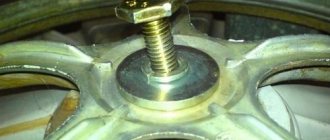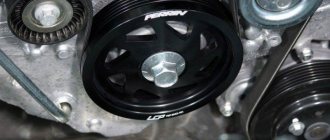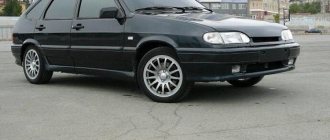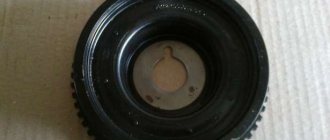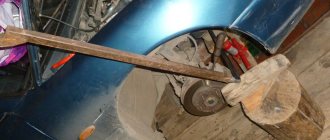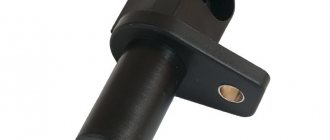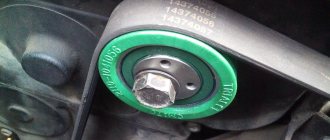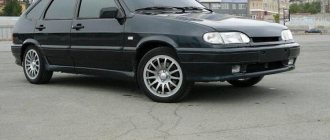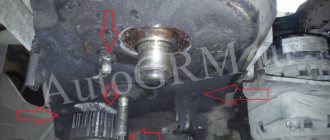01/26/2022 26 344 VAZ 2107
Author: Ivan Baranov
Many VAZ 2107 owners, in order to save on car service costs, master some repair and maintenance operations for their car. Sometimes during such operations it is necessary to remove the crankshaft pulley VAZ 2107 9) injector. The article provides detailed instructions and attaches a video that talks about replacing the crankshaft pulley when there is an oil leak.
[Hide]
What is the thread on the VAZ 2107 crankshaft pulley: description of the part and step-by-step instructions
The manufacturer recommends replacing the front crankshaft oil seal of VAZ 2101-2107 engines every 150,000 km. However, in practice such replacement has to be performed more often. Accelerated wear of the sealing element and the appearance of engine oil leaks are caused by:
In addition, we cannot rule out hardening of the cuff due to natural aging and the possibility of a manufacturing defect - unfortunately, the quality of parts for rear-wheel drive VAZ models leaves much to be desired.
Replacing the mechanism
If you replace the front oil seal, changing it is quite simple. But as for the rear, you will have to tinker with it quite a bit and spend more time. In the case of an injector, you can change the cuffs without removing the radiator.
Immediately before the work itself, you should place your VAZ-2107 in a pit and disconnect the battery.
Afterwards, it is extremely important to engage first gear - this way you can fix the crankshaft. Be sure to also securely lock the vehicle in place using the parking brake. The procedure itself takes place in the following stages:
- We unscrew the engine protection, remove the generator belt and remove the generator pulley.
- Now you can clearly see the oil seal - remove it with a screwdriver.
- We treat the new cuff well with oil and insert it into the right place.
- Then we put all the parts in place in reverse order.
When and why to change the front oil seal
It is impossible not to notice damage to the sealing element - the rotating pulley scatters oil in the front of the engine and throughout the engine compartment. However, do not think that such a malfunction only leads to oiling of the units and a decrease in the lubricant level. If engine oil gets on the generator belt and other rubber parts, it can quickly render them unusable.
Keep in mind that the appearance of a leak through the engine seals is provoked by another factor - increased crankcase gas pressure. For this reason, be sure to check the cleanliness of the engine ventilation system.
Step-by-step instruction
Due to the limited space between the front of the engine and the radiator, it is difficult to press in a new oil seal without distortion. For this reason, experts recommend replacing the sealing element with the front engine cover removed.
Of course, doing this on a mechanic’s workbench is much more convenient, but there are also pitfalls here.
As practice shows, after such dismantling it is difficult to restore the tightness along the junction line of the oil pan, and in addition, there is a danger of breaking the internal threads in a rather delicate duralumin cover.
Car battery heater
For this reason, we recommend using the more common and less labor-intensive method, in which the damaged oil seal is replaced directly on the engine. This work will require your attention and accuracy. It is more convenient to perform all manipulations on a lift, overpass or inspection pit.
To replace the crankshaft oil seal, you do not need any special knowledge or expensive tools. The work can be done with your own hands, spending 1-2 hours on it. By being careful in your work, you will forget about oil leaks for a long time and will be able to easily keep the engine compartment clean.
Good night everybody! Share your experience on how to unscrew the crankshaft pulley nut on a classic. I hit the key with a hammer, and with a sledgehammer too, the ratchet key just bends. I even tried using the starter, the starter just wouldn’t turn. How to unscrew the crankshaft pulley of a VAZ 2107.
Product description Slon 21214100505811
The Part-auto online auto parts store works exclusively with trusted suppliers of auto parts, which gives you confidence in purchasing truly high-quality spare parts. Available Slon spare parts are focused on the most popular models of automobile brands: Spare part 21214100505811 can be used in several modifications and models. To clarify applicability, you must send a VIN request and our specialists will check the compliance of the spare part with your car.
You can buy an original spare part “VAZ-21214i, 2104i, 2107i crankshaft pulley with damper” under the “Slon” brand and send the purchased goods to 2200 pick-up points or order courier delivery. The online auto parts store Part-auto.ru currently offers 0 analogue offers and 0 replacement offers from the supplier “Slon”. This part is used for installation on cars of the following brands:
The minimum cost of the spare part “VAZ-21214i, 2104i, 2107i crankshaft pulley with damper” is 1,992 rubles. The fastest delivery for trade offers is 2 days.
The VAZ-2107 is a luxury version of the simpler VAZ-2105 car, but everything also belongs to the general family of “classics” of the Volzhsky Automobile Plant. This brand of car was produced in Russia until 2012, so on the roads you can see both new examples of cars and honorary old men of thirty years of age.
This model differs from other classic VAZ cars in a large number of modifications associated with different engine sizes. The “sevens” were equipped with engines with a volume of 1.3 liters, 1.5 liters, 1.6 liters, 1.7 liters. On special models produced for the Ministry of Internal Affairs and the KGB, which were later decommissioned and fell into private hands, even rotary piston engines with a volume of 1.3 liters and a power of 140 hp were installed.
Such a variety of engine systems has led to the fact that the VAZ-2107 model has a fairly large range of spare parts, which are constantly in demand during repairs and periodic maintenance of these vehicles. Also, recently, a trend has developed towards deep tuning of this model, which consists in installing a more powerful engine and reinforced suspension, for the participation of modified cars in unrecognized, but quite popular street racing among young people.
Removing the pulley and replacing the crankshaft oil seal
Since I still have one VAZ 2106 engine in my garage, which has not yet been sold, I decided to use it as an example to show how to replace the crankshaft oil seal.
In many classic repair manuals you can read that to replace the front oil seal, you need to remove the cover from the front, since the space between the engine and the radiator is quite small to do this work without problems.
I will show everything with the engine removed, so there were much fewer problems experienced. So, first, here is a list of the necessary tools that we will need:
How to remove a pulley from a crankshaft
So, first of all, having stopped the pulley, unscrew the nut securing it:
When the nut is completely unscrewed, you can try to remove the pulley itself. This can be done simply by prying it from the inside with the same chisel, or using a special puller, as shown in the photo:
After which we can easily remove it, which can be seen in the picture below:
Replacing the front crankshaft oil seal
In my case, everything was simple, since the engine was removed from the car and replacement was not difficult. I used the same puller to pry it from the inside of the oil seal and carefully pulled it out:
Now you can install the pulley in place, making sure it is correctly installed on the key. You can consider the procedure complete, and the VAZ 2106 ready for use!
But I once again draw your attention to the fact that if you do everything on a car, then doing it is very inconvenient and it is possible that some will even remove the front engine cover.
Necessary tools and accessories
The replacement work, although not particularly complicated, requires the removal of a sufficient number of elements from the car.
The tools you will need are almost all common and can be found in any garage.
To carry out the work you will need:
Open-end and socket wrenches (for 10, 13, 14, 17, 19);
- Special wrench for the generator pulley nut (36 or 38);
- Powerful flat screwdriver;
- Wire;
- New chain;
- Rags;
- Chalk.
The chain drive requires constant lubrication, which is why it is located inside the engine under the drive cover.
Therefore, extensive preparatory work will be required to carry out the replacement work.
Crankshaft pulley
Every car enthusiast knows very well that most breakdowns and technical operations can be performed independently, saving good money. In this article we will talk about how to remove the crankshaft pulley without contacting a service center. We will consider all the nuances in detail, analyze the main problems and methods for solving them.
Where is the crankshaft pulley located?
The crankshaft pulley is hidden behind the generator. At the bottom of the engine compartment there is a disk that is tightly fixed to the clutch shaft; it is a pulley.
By design, this segment is divided into two types: conventional or with a damper. The latter have an additional massive external ring with a rubber gasket, which provides improved vibration absorption.
At first glance, the procedure may seem absolutely simple. However, there are several nuances.
It is necessary to fix the crankshaft so that it does not rotate. The high compression force of fasteners also causes a lot of trouble. When installing, the pulley bolt is tightened with a sufficiently large force.
To prevent it from unscrewing spontaneously, the degree of clamping gradually increases during operation of the power unit. This fastening system is determined by the need for increased reliability of fixation of the nuts.
After all, if you accidentally unscrew it, serious damage can occur, due to which costly repairs cannot be avoided.
How to unscrew the pulley nut in rear-wheel drive models
The pulley is held in place by a nut that is located at the end of the crankshaft. This design solution is presented in all rear-wheel drive VAZ cars in models from 2101 to 2107, Niva, etc. This fastening element is also called a ratchet due to the presence of a ledge for a crooked starter.
For maximum convenience in performing this work, it is recommended to place the machine above the inspection hole. To fix the crankshaft, you need to put the gearbox in the 4th gear position and turn on the handbrake. During the work we will need the following tools:
If you cannot unscrew the nut using the lever, do the following:
The nut should move, if not on the first, then on the second try. After this, it can be easily unscrewed using a regular key.
How to unscrew a pulley bolt in front-wheel drive models
The bolt is used as a fastening element for the crankshaft pulley in front-wheel drive vehicles. In such models, the block is placed perpendicular to the axis of the car. Unlike dismantling the nut in rear-wheel drive modifications, this method requires more time due to the need to remove additional parts. To perform the work you need to prepare the following tools:
How to remove the crankshaft pulley
The operations described above are the most complex; all subsequent steps can be completed without much effort. In this case, all stages must be carried out as carefully as possible so as not to damage important segments of the car. To remove the crankshaft pulley, you need to perform a number of additional operations. They include the dismantling of related components and parts.
Many people are interested in what thread is on the crankshaft pulley. The answer is simple, unscrew the bolt or nut counterclockwise.
Removing the crankshaft pulley using traditional methods
If the threaded connection does not give in, it can be unscrewed with minimal effort using special liquids. There are a number of active mixtures that corrode corrosion and smooth out rubbing surfaces. Special oils of the “WD” series are considered to be quite effective and the most widespread. You can also use vinegar or brake fluid.
In addition to unscrewing the fastening segments, problems may arise with removing the part itself. You can dismantle the pulley using a pry bar, carefully prying it up alternately from different sides. In the most hopeless cases, special pullers are used. They are a stud with a nut that has several grips.
Modernization of shock absorbers
Not every owner likes the soft suspension of the 7. To make the car more assembled, reduce roll and sway, and increase rigidity, car enthusiasts resort to modifications, replacing original shock absorbers with products with other characteristics. For example, to stiffen the rear suspension without any modifications or alterations, you can install shock absorbers from Niva. Based on the reviews of many owners of the “Seven”, after such changes the car becomes a little stiffer and holds the road better.
Double
To install dual shock absorbers you will need:
- 4 rear shock absorbers;
- set of heads, screwdrivers, keys;
- hammer;
- welding machine.
The essence of the modification comes down to the fact that it is necessary to manufacture and attach to the body a bracket for the second damper.
Installation of the latter to the rear axle is carried out together with a standard shock-absorbing element using a long bolt or stud. The procedure is carried out the same way on both sides.
With such modifications, it is recommended to install new shock absorbers.
Sports
If the car is modified for a sporty driving style, then the changes apply not only to the rear, but also to the front suspension. For such purposes, it is convenient to use a suspension kit, which includes springs and shock absorbers. Depending on the goals pursued, the installation of such elements is possible both without changing the ground clearance and with lowering the suspension, ensuring maximum rigidity in all modes of damper operation. The kit allows you to get excellent car handling. However, you can install sports elements separately - in front or behind, which depends only on your wishes. One of the common options for sports shock absorbers installed by owners of “sevens” and other “classics” is PLAZA SPORT. Installation is carried out in place of standard parts without any modifications.
The seventh model Zhiguli is technically a fairly simple car. However, poor quality road surfaces often lead to failure of suspension shock absorbers. It is not difficult to identify malfunctions of these elements even in a garage, as well as to replace them. To do this, it is enough to prepare the necessary set of tools, read the step-by-step instructions and follow them during the work process.
How to remove a crankshaft pulley with your own hands
Many drivers prefer to carry out minor repairs to their car themselves; this not only reduces expenses from the family budget, but also a great way to spend time. Each such motorist will sooner or later have to face the problem of removing the crankshaft pulley of a car.
In most cases, a car enthusiast thinks about how to remove the crankshaft pulley when he first encounters the need to replace the seals.
Over the course of their service life, they dry out, crack and begin to leak oil, and this problem cannot be solved without removing the pulley.
At first glance, the task is not difficult, but as practice shows, in reality you may encounter some difficulties:
As we already wrote above, the crankshaft pulley can be secured with either a bolt or a nut.
Unscrew the pulley nut
The nut is used mainly in rear-wheel drive cars: classic VAZ 2101–2107 and Niva. To perform this procedure, we will need an overpass or inspection hole. First of all, put the gearbox in 4th gear and squeeze the handbrake. We will need the following tools:
If, using the lever, it was still not possible to unscrew the nut, then we try the following:
Unscrew the pulley bolt
The bolt is used primarily in the design of front-wheel drive vehicles. In this case, the block is located perpendicular to the axis. The process of unscrewing the bolt is a little more difficult because it is more difficult to get to. To perform this operation you need:
Now let's move on to the process of unscrewing the bolt, the order of our actions will be as follows:
Removing the crankshaft pulley
If you have already removed the bolt or nut from your crankshaft pulley, then further removal steps will be much easier. In the absence of special tools, this can be done with a regular pry bar, alternately prying it from one side or the other. When doing this, be careful not to use excessive force to avoid damaging the key and groove.
So we figured out how to remove the crankshaft pulley with your own hands. The process is not too complicated, but in any case, when you perform car repairs yourself, you need to be careful. Be careful and attentive, and everything will work out for you!
Source
In what cases should the pulley be removed?
Most often, it is necessary to dismantle the crankshaft pulley when changing oil seals. The role of the O-rings is to prevent oil from the crankcase from reaching engine components. Over time, the seals wear out, crack, and as a result, oil leaks appear. To fix this, you need to change the seals. During this procedure, you have to remove the crankshaft pulley.
Also, the need to dismantle the crankshaft disk arises when replacing the timing belt on a VAZ 2107 injector. It is changed according to the regulations specified in the operating instructions for the VAZ 2107 injector, as it wears out after a visual inspection or if it breaks. During a technical inspection, the pulley must be inspected to identify any defects. If chips or scratches are found, the part should be replaced.
The procedure for removing the product itself is not difficult, but some problems arise.
Firstly, with access. The pulley we are interested in is located in the lower part of the engine compartment behind the generator. It is difficult to get to because other engine components are in the way. Before removing the pulley, you need to remove the alternator and power steering belt.
Secondly, the crankshaft pulley mounting nut is very difficult to unscrew. When it is put in place, it is screwed with great effort. This is necessary so that it does not unscrew accidentally while the car is moving, as this can lead to expensive repairs. While the engine is running, the nut is tightened even more. In addition, the process is aggravated by high operating temperatures, at which oil coking and metal corrosion occur under the influence of the external environment.
Reasons why replacement is required
The main reason for the need to replace the timing chain drive on a VAZ-2107 is the strong stretch of the chain.
If, when checking the tension, a strong deflection is observed, especially if the car has already had a significant mileage, then most likely the chain has stretched so much that its tension will no longer be able to fix the problem.
Of course, a strong weakening of the chain can also be caused by its tensioner, but in this case we will consider the critical stretching of the element and the need to replace it.
As for the tensioner, you can read more about it here.
Also, if chips or signs of severe wear are found on the drive links, it is advisable to perform a replacement with an additional inspection of all elements with which the chain is in contact in order to determine what caused the same chips to appear.
In general, in order to delay as much as possible the need to replace the chain drive on a VAZ-2107, it is enough to only periodically monitor the condition and tension of the chain and, if any defects are detected, eliminate their cause.
Removal instructions
With the clutch disengaged, the crankshaft can be easily turned with a wrench.
To carry out the removal procedure, it is necessary to secure the shaft from turning.
Removal and Installation
On a VAZ 2107, the injector crankshaft pulley is held in place by a fastening nut. Another name for it is ratchet. To remove the crankshaft pulley, you will need to unscrew this nut. It is better to carry out work on an inspection ditch or overpass. The tools you need to prepare are:
If the threaded connection is difficult to unscrew, there are special products, after application of which you can easily unscrew the fasteners. These products include WD oil. You can also use vinegar essence or brake fluid.
Work on dismantling and installing the crankshaft pulley on a VAZ 2107 injector consists of the following steps:
How to remove the crankshaft pulley?
Once you have dealt with the potential difficulties of dismantling, you can get to work. As a rule, the pulley is secured using a nut (on rear-wheel drive vehicles) or a bolt. The biggest problems arise with the first fastening option.
The crankshaft pulley is secured with a nut
Mounting nuts often have risers to provide a "ratchet" grip. In service conditions, craftsmen use “thirty-eight” or “thirty-six” socket wrenches. To speed up the twisting process, an elongated handle and a special fixing device are used, which is placed on the pulley. But how to unscrew the crankshaft pulley when there is no access to a special tool?
In such a situation, proceed as follows:
Video “Replacing the crankshaft pulley on a VAZ classic”
This video talks about oil leakage due to wear on the crankshaft pulley.
The crankshaft on a VAZ 2105 is removed either to replace it with a new one or to replace its bearings. To carry out repair work, the car must be driven into an inspection hole, overpass, or use lifts. We also prepare a standard set of tools. The procedure for carrying out repair work is as follows:
This completes the process of disassembling and removing the crankshaft of the VAZ 2105. In general, repair work related to the piston group, boring the crankshaft and replacing liners and main bearing caps is recommended to be carried out with the appropriate experience and knowledge, or contact a specialized workshop.
What is a crankshaft sensor ? In order to synchronize the ignition operation and fuel supply to the cylinder blocks on an injection engine, it is necessary to determine the crankshaft speed. This is precisely why you need a crankshaft position sensor , which is installed opposite a special synchronization disk mounted on the crankshaft.
why do the timing marks on the vaz 2107 not match?
When, for some reason, the timing phases are lost, a simple operation is necessary to restore them. Let's analyze this situation using the example of the most common VAZ cars, the classic VAZ 2101-07 models. Option when timing timing is out of whack It is necessary to remove the valve cover and turn the engine crankshaft until the mark on its pulley aligns with the long mark on the front engine cover.
Then you need to see if the marks on the camshaft sprocket and the marks on its bed match. If the marks do not match, and the mark on the sprocket is not visible at all, then proceed as follows. We turn out all the spark plugs and turn the crankshaft a quarter turn and check the position of the pistons in the cylinders, for example, with a screwdriver with a long blade. The pistons must be located in the middle part of the cylinders, which will guarantee the safety of the valves meeting the pistons when turning the camshaft.
Then release the tensioner bolt, remove the camshaft sprocket mounting bolt and remove it along with the chain. Next, you need to remove the chain from the sprocket and put it back on the camshaft and secure it with a fastening bolt, without tightening it too much. Next, turn the camshaft by the sprocket mounting bolt until the marks on the camshaft bed and the sprocket coincide. Then we remove the sprocket and chain again and, holding the chain in our hands, rotate the crankshaft until the marks align. Having orientated the sprocket by the mark so that during installation it aligns with the mark on the camshaft bed, we install it on the camshaft. If the mark is shifted a tooth or two forward or backward, remove it again and turn it inside the chain by a tooth or two and set it again to check the marks.
Pulley removal
Unscrewing a fastening bolt or nut is only half the battle. Next you need to pull out the pulley
from the shaft. The pulley cannot be removed easily by hand unless its seat is broken. In addition, if the pulley fits tightly onto the shaft, it is also secured against turning by a key.
READ How to Clean the Carburetor on a VAZ 2107
There are special pullers for removing the pulley from the shaft. There are mechanical and hydraulic pullers.
The design of a mechanical puller is simple. Usually it has three legs, with which you need to hook the pulley itself, and rest the central rod against the shaft. After which, you need to rotate the rod, the legs will straighten and pull the pulley towards you. There are even simpler pullers that you can make yourself. If there is no removable device for the pulley, then you can use pry bars. If one person is filming, then take turns, moving it a little on each side so that there is no distortion. If there are two, then at the same time, from different sides, the pulley is pressed out from the crankshaft with a sharp movement.
It also happens that when using a puller, the walls of the pulley grooves cannot withstand and break off. Therefore, when using pry bars, they must be engaged as close to the shaft as possible.
Moskvich 2141 1991, 101 l. With. — tuning
Cars for sale
Moskvich 2141, 1993
Moskvich 2141, 1992
Moskvich 2141, 1993
Moskvich 2141, 1999
Comments 32
Class! I did the same for myself!
Damn, how much did I saw off the seat for the oil seal, or rather, how much was left on the pulley from the plane...
I don’t even remember, it’s easier to take the original one and the pulley and try it on
Damn, how much did I saw off the seat for the oil seal, or rather, how much was left on the pulley from the plane...
Bring it to the boring machine turner along with the original UZAM pulley, and tell me to make me a landing tail on the VAZ pulley the same as on the UZAM pulley.
It’s not very clear what I sharpened where at the bushing expense. and what I pressed where. Can you be more specific?
Tell me how to knock out the teeth on the pulley at what distance from TDC. and which tooth should have DPKV?
Grind the teeth completely with a grinder, the dpkv is on the 20th tooth in rotation
How many teeth should I file down?
How much did you buy the pulley in amounts?
Oh yes, I almost forgot to take the DPKV from 2107 too? What do you have and how? The fastening there still needs to be tricky. it's not visible in the photo
this is just handsome! bracket)) I can’t do this myself ((exactly. But can you make one for me?
You yourself will have to comprehend the art of wielding a file, like a true Muscovite master! walk this difficult path, remember all the devils, and drink more than one liter of beer!
I see, do you still have aluminum corners like these? and most importantly, what did you cook it with? I would like at least some preparation! sawing and turning is the second half of the job. You will still have to do the adjustment in place
I bought a piece of corner at Yangi-Obad, I didn’t even think about taking it in reserve (aluminum turned out to be not cheap), I was still buying it for the adapter plate. Argon workers cooked it together with the collector.
It's clear. what kind of nuts are on the pump? with the new pulley what will move where? or will the belt and other pulleys remain in place? www.drive2.ru/cars/moskvi…/rolloff/journal/2685647/
with this pulley you need to pull out the pump pulley
but it’s clear, in general, it all needs to be adjusted in place and the generator will also have to be shifted, everything in front will come out, as I understand it, about 5 mm. but in any case, you need to make a pulley first.
Hello fellow countryman. Help me please, I also want to make a pulley like yours. As I understand it, I don’t need a pulley from a 2107 injection machine, my pulley is a standard and, most importantly, a turner with even hands. I’ll buy a pulley, but where can I find this turner? I have been following your work and records for a long time, and every day I want more and more to do all the work that you did, especially since I already have half of the MPSZ installed, even it cannot work normally on the distributor with backlashes, from which you simply cannot get rid of. If you have the opportunity to help me, write. please at this stage I need help in making a pulley.
Signs of a malfunction of the VAZ 2107 crankshaft position sensor
Removing the crankshaft position sensor
Checking the crankshaft position sensor VAZ 2107
Welcome! Have you ever seen the bottom of an engine splattered with motor oil? Usually, people who have little knowledge of how a car works, the first question they ask is: “Why does this happen?”
A car's engine can become oily for various reasons, but the main reason is deformation of the oil seals. From time to time they require replacement with new ones. Let's figure out what they are and why they are needed. People say the oil seal, its real name is silent block, is a rubber-metal joint consisting of two metal bushings with a rubber insert between them. Oil seals serve as connections between suspension parts. Due to the elastic (rubber or polyurethane) insert between the bushings, vibrations transmitted from one unit to another are dampened. The silent block experiences very heavy loads, because its main task is to resist the deformation received by the car’s suspension.
Note! You will need the following tools: wrenches, a special “36” wrench designed to unscrew the crankshaft pulley mounting nut, a pair of screwdrivers, a mounting blade, a mandrel, a hammer and a bit!
Summary:
Location of the front crankshaft silent block
Silent blocks are found not only in the front suspension of the car (here they attach levers, anti-roll bar, torque rods), but also in the rear suspension (they attach the bar). Moreover, their range of applications includes shock absorbers, gearboxes, and engines. These important details require constant and timely monitoring. Today we will talk specifically about the front silent block on the classic VAZ model. So, it is located in a special hole located in the camshaft drive cover. So that when you open the hood you can easily find it, look at the photo below. The camshaft drive cover is circled in red, and the crankshaft pulley is indicated by a blue arrow. The oil seal is located directly behind it.
Sequence of work
Having everything you need, you can start working.
On a carburetor car.
Next, we will look at how to replace the chain drive on a VAZ-2107 with a carburetor power system.
The VAZ-2107 is installed on a flat surface or in a garage, and is immobilized using wheel chocks and a handbrake.
To ensure good access to all the necessary elements, it is advisable to remove the radiator grille, drain the liquid and dismantle the radiator itself.
You don’t have to do this, but the ease of performing the work will significantly deteriorate. If there is a pallet protection, it will also have to be dismantled.
Then the generator drive belt is loosened and removed. Next, you will need to dismantle the pump drive pulley.
The valve cover is also removed from the engine, providing access to the camshaft sprocket.
Next, all adjustment marks are installed. To do this, you need to rotate the crankshaft until the marks on the camshaft sprocket match the casting on the head.
In this case, the mark on the crankshaft pulley should coincide with the lower of the three marks on the drive cover. The label you want is the longest.
After this, use a special wrench to unscrew the nut securing the crankshaft pulley, and this pulley is removed.
The bolt securing the camshaft sprocket is also unscrewed, having first bent the petals of the lock washer of this bolt with a screwdriver.
To easily unscrew this bolt, the gearbox must be set to 4th gear. Before removing the sprocket, you need to check the alignment of the marks again. After removing the sprocket, it is better to keep the chain taut. To do this, a hook is made from wire and the chain is hung with it.
Next, the tensioner is removed from the engine.
Read more about this here.
After this, you can begin to remove the cover. To do this, you need to unscrew the three bolts securing the pan to the cover, as well as the nuts and bolts securing it in the front of the engine.
Carefully prying it off with a screwdriver, separate it from the crankcase and remove it, after which you will have access to all the sprockets that drive the chain.
Before removing the remaining sprockets, it is advisable to put marks on them and the crankcase, which will allow them not to disturb their position during assembly.
Using a 17 wrench, unscrew the bolt securing the auxiliary shaft sprocket, after which it is removed.
Then, using the same key, unscrew the bolt securing the tensioner shoe, after which it is removed.
To remove the chain from the crankshaft sprocket, you will need to unscrew the limit pin installed at the bottom. After this, it will be possible to completely remove the chain.
Installation of a new chain and assembly are carried out in complete reverse order. In this case, you need to carefully monitor the coincidence of all marks.
This is especially true for the auxiliary shaft sprocket; if its position is disturbed, you will need to install the ignition after assembly.
After final assembly, you will need to tension the chain, as well as check that all marks match by turning the crankshaft several times until the marks match again.
Features of replacement on an injection engine.
This describes the replacement sequence on a carburetor car. But the latest versions of the VAZ-2107 already came with an injection power system.
However, the differences in the sequence of replacement work on this engine are no different from the carburetor, with the exception of the need to remove the crankshaft position sensor during the preparatory work.
As you can see, the whole difficulty of replacing the timing chain on a VAZ-2107 lies in the need to remove many elements of the power plant and ensure that the marks match.
And yet, it is quite possible to perform this operation yourself, the main thing is to be careful.
Welcome! Have you ever seen the bottom of an engine splattered with motor oil? Usually, people who have little knowledge of how a car works, the first question they ask is: “Why does this happen?”
A car's engine can become oily for various reasons, but the main reason is deformation of the oil seals. From time to time they require replacement with new ones. Let's figure out what they are and why they are needed. People say the oil seal, its real name is silent block, is a rubber-metal joint consisting of two metal bushings with a rubber insert between them. Oil seals serve as connections between suspension parts. Due to the elastic (rubber or polyurethane) insert between the bushings, vibrations transmitted from one unit to another are dampened. The silent block experiences very heavy loads, because its main task is to resist the deformation received by the car’s suspension.
I couldn’t get the crankshaft pulley off, what should I do?
If you succeed in breaking the fastening, unscrewing the nut completely is not difficult. But this doesn't always happen. In case of negative circumstances, use a different technique:
As noted above, on many front-wheel drive vehicles, the pulley is secured using a bolt.
In this case, the algorithm should be as follows:
1. Raise the vehicle from the right side, and then place some kind of stand under the body (for reliability). It could be a piece of log.
3. To fix the crankshaft, remove the plug in the clutch housing and install something metal, such as a mounting bracket, into the opening. With the other side, rest the tool against the teeth.
4. Place the head of the wrench on the bolt, and then use the extension to make several jerks to the left. This is necessary to at least rip the bolt from its original position. Most attempts are successful. If this does not help, use the method described a little above (with starting the starter).
To help you unscrew the nut (bolt), treat it with WD-40. In this case, it will be easier to tighten the bolt (nut). After completing the work, all that remains is to remove the pulley using a special puller or pry bar.
Replacing the front silent block of the crankshaft on a VAZ 2101-VAZ 2107
Note! Today there are two replacement methods: fast and slow. Although the second method requires more time, it is more accurate. The choice and decision are yours! (The slow method is described in the article, and the fast method is demonstrated in the video at the end of the article).
Removal
1) At the beginning of the operation, remove the camshaft cover from the car engine. (read more about the process in the article: “Replacing the chain tensioner shoe”, in paragraphs “1-8”)
Note! If you have experience in replacing oil seals, then you do not have to remove the cover, but replace the oil seal immediately on the installed cover.
Keep in mind that there will be little space to replace the oil seal; there is a possibility that the oil seal will be pressed into the drive cover at an angle. Then you will need to replace the oil seal again with the cover removed.
2) After removing the cover, carefully remove the silent block using a hammer and bit.
Note! Remove the oil seal only from the inside of the cover, otherwise removal will be problematic!
Installation
1) Using engine oil, lubricate the new part and install it in place on the outside of the cover. When installing the oil seal, be sure to orient its working edge towards the centering protrusions indicated by the letter “a”.
Note! In the photo below you can see that the working edge differs only in the presence of a spring!
2) Next, using a mandrel of a suitable diameter and a hammer, press in the oil seal until it stops.
3) Now pick up the previously removed camshaft cover gasket and assess its condition. If there is severe compression or deformation, replace the old gasket with a new one.
Note! To ensure that leaks through the gasket are eliminated in the future, it is recommended to apply a thin layer of silicone sealant on both sides.
For ease of installation of the lid, we recommend using glue to glue the gasket to the lid itself - it will not fly off.
4) Next, install the cover together with the gasket installed on it. Install the bolts and nuts securing the cover.
5) Then, using a special mandrel, center the drive cover so that it is level with the crankshaft.
Note! If there is no mandrel, use the previously removed crankshaft pulley and center the cover: install the pulley and tighten the fastening nut.
6) Lightly tighten the bolts and nuts securing the cover.
7) Finally, wrap them crosswise.
Finally, tighten the oil pan to engine bolts.
Note! Install the remaining parts in the reverse order of removal.
Additional video
The video will help you understand in detail the process of replacing the oil seal; detailed instructions are provided here. Enjoy and useful viewing!
Removing the crankshaft
on the injector of VAZ 2107
Many VAZ 2107 owners, in order to save money on car service, master some repair and maintenance operations for their cars. Sometimes during such operations it is necessary to remove the crankshaft VAZ 2107 9) injector. The article provides detailed instructions and includes a video that explains how to replace a crankshaft pulley with an oil leak.
Replacing the rear oil seal
Now we are changing the rear crankshaft oil seal (bushing) on a VAZ 2107. This will require more time, patience and effort, since to access it you need to disable the gearbox. All preparatory work is carried out to the same extent, but the car is in neutral. Since you will have to hang the rear wheels, this should be done in a hole rather than on an overpass. The outer dimension of this oil seal is 90mm and the inner dimension is 70mm.
First you need to disconnect the cardan from the gearbox:
- raise and suspend the rear wheels;
- if the VAZ 2107 is an injector, remove the heat shield of the catalytic converter (13 mm socket wrench) by unscrewing the 4 nuts from the studs (see figure). If the VAZ 2107 is not an injector, but a carburetor, skip this step.
- Now you can start removing the driveshaft. Important! Take a file and make a mark on the cardan fork and on the gearbox (differential) flange. When everything is put into place, it must be locked in this relative position to avoid vibrations and imbalance. That's what a label is for.
- Unscrew (with a 13 mm wrench) the driveshaft from the gearbox flange, holding the driveshaft from slipping with a crowbar. Now let's hang the rear part of the stabilizer on a cable to the rear suspension where you want it.
- disconnect the front part of the propeller shaft: unfold the antennae of the oil seal holder (4 pcs.), slide it along the propeller shaft. We unscrew the bolts securing the intermediate cardan support (2 pcs.) from the bracket and disconnect the shaft with the elastic coupling by moving the shaft back. Congratulations! The driveshaft is disconnected. Now you need to remove the gearbox to gain access to the rear oil seal:
- First, the central panel of the radio is removed in the cabin. You will need a 10mm wrench, pliers and screwdrivers. Unscrew the two console nuts on top. Then use a flathead screwdriver to pry up the decorative trim at the bottom, remove it and unscrew the bottom screws. We disconnect the toggle switches for lighting and heated rear window and pull out the connectors, disconnecting them. First you need to remember the connection diagram. Finally, lift the panel up and back slightly, release the shift lever and remove it.
- then remove the decorative covers of the gear shift knob. Then lift the handle, use a flat-blade screwdriver to tighten the lock and remove the handle. Carefully remove the shock absorber (rubber) from it, using tweezers. Using two screwdrivers, we disconnect the petals of the locking ring and remove the latter and its two bushings: one rubber and one locking.
- Unscrew the screws of the gear handle cover (using a Phillips screwdriver) and remove it with the foam seal.
- move the trim and unscrew the trim in the floor;
- open the hood, unscrew the starter mounting bolts and move it back. As a result, it will issue a checkpoint call.
- disconnect the elastic joint of the universal joint. Attention! In order to correctly install it in its original position after replacing the oil seal, it must first be tightened with a special clamp.
- Using an open-end wrench (19 mm), unscrew the nuts on the coupling bolts and the crosspiece of the gearbox shaft (3 pcs.). Next, remove the coupling along with the gasket and ring.
- Now, using the same wrench, unscrew the nuts securing the front flange of the cardan and remove it. These and the previous 6 nuts are self-locking, you will need new ones to reassemble!
- From the gearbox you need to disconnect the wires going to the white reverse light and the drive to the speedometer shaft.
- Now, without removing the hose, disconnect the hydraulic drive and clutch cylinder from the gearbox. Next, remove the clutch housing cover itself. It is necessary to unscrew 2 bolts with a 10mm socket wrench.
- Important! Now you need to install a support under the gearbox so that it does not fall on your head and the bolts are not deformed!
- take a 19mm socket wrench with an extension. It is necessary to unscrew the 6 bolts that secure the gearbox to the engine block. Now, using a flat-head screwdriver, pry the gearbox housing off the edge, remove it from the studs, rock it and remove the gearbox from the car, pulling the engine input shaft out of the clutch disc. Important! The box must not be distorted. The preparatory work is done! You can start replacing the rear oil seal. To do this:
- remove the flywheel and clutch disc, for this we use a 10 mm socket wrench. It is necessary to unscrew 2 nuts on the shield;
- Before replacing the oil seal, it is necessary to remove its support so as not to damage the crankshaft flange. The figure clearly shows 6 bolts securing it and 2 bolts of the rear part of the oil pan, A and B. They also need to be unscrewed, since they are screwed into the oil seal holder body. Attention! There is a gasket between the oil seal holder and the cylinder block body. And if you have come a long way to the oil seal, do not be lazy and change it regardless of the conditions.
- We release the oil seal from the holder mandrel, to do this we fix it in a vice and remove it through a special slot with a flat-head screwdriver. The oil seal is checked for damage and wear.
- The seat is cleaned again with clean gasoline, the new oil seal is lubricated with clean engine oil and pressed into the holder using the bearing spindle or the old oil seal.
- To assemble, you must perform all steps in reverse order.
Congratulations! If you managed to reach the rear oil seal yourself, change it and reassemble (in reverse order) the disconnected components, you have passed the Advanced Amateur: Auto Mechanic exam with honors.
The front oil seal of the VAZ 2101-2107 engine is used to prevent engine oil leakage at the point where the auxiliary drive pulley is attached to the end of the crank. Although the sealing lip is made of high quality fluoroelastomer rubber, over time the sealing lip wears and lubricant leaks into the gap. Today we will share a method for replacing the front crankshaft oil seal on “classic” VAZs. Even a novice driver can handle the job, because to do this you don’t even need to remove the camshaft drive cover from the engine.
When and why to change the front oil seal
It is impossible not to notice damage to the sealing element - the rotating pulley scatters oil in the front of the engine and throughout the engine compartment. However, do not think that such a malfunction only leads to oiling of the units and a decrease in the lubricant level. If engine oil gets on the generator belt and other rubber parts, it can quickly render them unusable.
Keep in mind that the appearance of a leak through the engine seals is provoked by another factor - increased crankcase gas pressure. For this reason, be sure to check the cleanliness of the engine ventilation system.
Step-by-step instruction
Due to the limited space between the front of the engine and the radiator, it is difficult to press in a new oil seal without distortion. For this reason, experts recommend replacing the sealing element with the front engine cover removed.
Of course, doing this on a mechanic’s workbench is much more convenient, but there are also pitfalls here.
As practice shows, after such dismantling it is difficult to restore the tightness along the junction line of the oil pan, and in addition, there is a danger of breaking the internal threads in a rather delicate duralumin cover.
Car battery heater
For this reason, we recommend using the more common and less labor-intensive method, in which the damaged oil seal is replaced directly on the engine. This work will require your attention and accuracy. It is more convenient to perform all manipulations on a lift, overpass or inspection pit.
To play it safe, make sure you have a puller in your arsenal. With its help, you can easily and safely dismantle even those parts that are installed with a noticeable interference.
To replace the crankshaft oil seal, you do not need any special knowledge or expensive tools. The work can be done with your own hands, spending 1-2 hours on it. By being careful in your work, you will forget about oil leaks for a long time and will be able to easily keep the engine compartment clean.
Good night everybody! Share your experience on how to unscrew the crankshaft pulley nut on a classic. I hit the key with a hammer, and with a sledgehammer too, the ratchet key just bends. I even tried using the starter, the starter just wouldn’t turn. How to unscrew the crankshaft pulley of a VAZ 2107.
Shock absorber malfunctions
There are a number of indicators by which you can determine that the shock-absorbing elements of your car have become unusable and will need to be replaced in the near future. Otherwise, difficulties will arise in driving the car, and the braking distance will increase.
Oil leaks
The simplest sign indicating damper wear is the appearance of oil smudges on the body, which can be determined by visual inspection.
If such signs occur, it is recommended to verify that the element in question is faulty by sharply pressing the rear fender with your hands and releasing it. If the part is working properly, the suspension will slowly sag and return to its original position. When the shock absorber is not functioning properly, the rear of the vehicle will bounce on the spring, quickly returning to its original position.
Video: identifying a faulty damper without removing it from the car
Knock and squeak when driving
The most common cause of knocking in shock absorbers is fluid leakage. If there are no signs of leakage, it is necessary to carry out the test described above with the machine rocking. The knocking noise may also be the cause of damper wear. If a part has traveled more than 50 thousand km, then you should think about replacing it. Common causes of knocking also include air entering the outer cylinder of the damper due to an oil leak. You can try to fix the problem by bleeding it. If, while the car is moving, a squeak is heard from the rear suspension, then the cause of the malfunction may be worn rubber bushings of the upper and lower shock absorber lugs.
Uneven tire wear
Problems with shock absorbers can also be noticed by uneven tire wear, which significantly reduces their service life. This is explained by the fact that while driving with a faulty damper, the wheels often come off the road surface and cling to it again. As a result of this process, the rubber wears unevenly. In addition, you can notice wear in the form of patches, which is due to imbalance of the wheels. Therefore, the tire tread condition must be periodically monitored.
Sluggish braking
If the shock-absorbing elements are faulty or there are problems in their operation, the contact of the wheels with the road surface worsens. This leads to short-term tire slippage, reduced braking efficiency and increased brake pedal response time, which in some cases can lead to accidents.
Plunging and pulling of the car to the sides when braking
Malfunction of the shock absorber valves, as well as wear of the seals inside the product, can cause noticeable swaying of the body when you slightly press the brake pedal or move the steering wheel. A clear sign of a malfunction is strong body roll when cornering, which also often requires steering. A malfunction of the shock-absorbing elements is also indicated by dives of the front or rear of the car during sudden braking, i.e., when the front end drops strongly and the rear lifts up. The vehicle may pull to the side, for example, if the rear axle is not installed level. This is possible when the longitudinal rods break and subsequent poor-quality repairs occur.
Car instability on the road
If the “seven” behaves unstably while moving and is thrown to the sides, then there may be many reasons for this behavior. It is necessary to inspect the condition of the elements of both the front and rear suspension, as well as the reliability of their fastening. Regarding the rear of the car, it is worth noting that attention should be paid to the condition of the shock absorbers, rear axle links, and rubber seals.
Shock absorber ripped out
Sometimes VAZ 2107 car owners encounter such a problem when the mounting rings of the rear suspension shock absorbers break off. This problem arises when installing spacers under original springs or springs from a VAZ 2102, VAZ 2104 in order to increase ground clearance. However, with such changes in length, the standard shock absorbers are not enough and the mounting eyes tear off after a while.
To prevent this from happening, it is necessary to install a special bracket, which reduces the shock absorber stroke.
There is another option - to weld an additional “ear” below the old damper, which will also reduce the stroke and prevent failure of the suspension element in question.
When should the pulley be removed?
It is most common to remove the crankshaft pulley when changing oil seals. The role of O-rings is to prevent oil from the crankcase from reaching engine components. Over time, lubricating oils wear out and crack, leading to oil leaks. To fix this you need to change the constrictions. During this procedure you will need to remove the crankshaft pulley
Also, the need to dismantle the crankshaft drive arises when the timing belt is replaced with a VAZ 2107 injector. It is changed in accordance with the rules specified in the operating instructions for the VAZ 2107 injector, since it wears out after visual inspection or breakdown. During the technical inspection, the pulley must be inspected for any defects. If scratches are found, the part must be replaced.
Source

